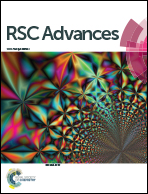Synthesis of dual functional pyrimidinium ionic liquids as reaction media and antimicrobial agents†
Abstract
The development of materials with intrinsic synergistic properties has attracted great interest in the fields of chemistry and materials science. This article describes the design of and a concise two-step synthetic route to twenty N-alkyl pyrimidinium ionic liquids with the ability to be used as reaction media and antibacterial agents. These synergistic materials have been synthesized by the N-alkylation of pyrimidine, a precursor of nucleobases, with varied n-alkyl (C1–C10) halides followed by anion metathesis of the resulting pyrimidinium halides using the salt of the counter anions, tetrafluoroborate (BF4−) and bis(trifluoromethanesulfonyl)amide (NTf2−) in good to excellent yields. With these newly synthesized quaternized pyrimidinium ionic liquids (PyrILs), the studies of solubility/miscibility in common solvents, solute–solvent interactions using UV-visible spectroscopy, compatibility as a designed solvent for chemical reactions and evaluation of antimicrobial properties were conducted. The assessment of biological properties of all the PyrILs with BF4− counteranion against several microorganisms revealed that the [C9Pyr]BF4 and [C10Pyr]BF4 containing longer alkyl chains are potential antibacterial agents showing excellent bioactivity against both Gram-positive S. aureus (MIC = 8 and 4 μg mL−1, respectively), and Gram-negative E. coli bacteria (MIC = 8 and 4 μg mL−1, respectively).


 Please wait while we load your content...
Please wait while we load your content...